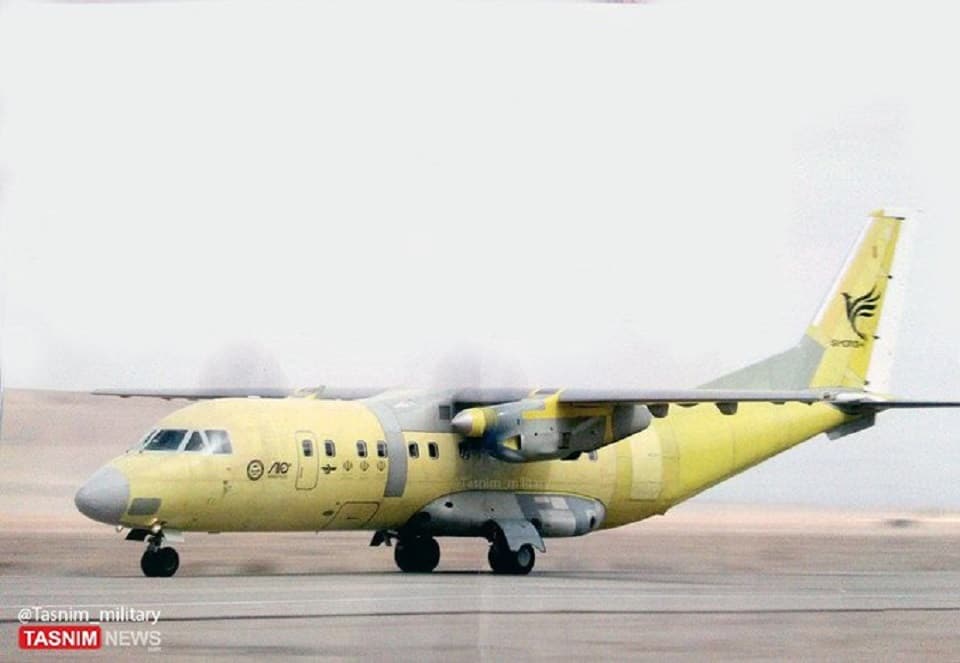Aerospace
Simorgh, Iran’s first transport turboprop, had its maiden flight.

Today at Shahin-Shahr, Isfahan, Iran’s “Simorgh” tactical transport aircraft of IAMI / HESA (Iranian Aircraft Manufacturing Industries) successfully completed its first flight. The Antonov/IAMI IrAn-140-100 aircraft used for the prototype underwent six years of modifications to become the Simorgh.
Iranian B747 aircraft Part Of Plane’s Engine Falls Off In Mid-Air(Opens in a new browser tab)
An Iranian light transport aircraft named HESA Simourgh was displayed on May 19, 2022. The aircraft can carry cargo or even troops and is a modified version of the Iranian IrAn-140 turboprop airliner, which was based on the An-140.
Iran’s HESA (Iran Aviation Industries Organisation) created the Simourgh light transport aircraft for a variety of civil and military uses. The Simourgh is made to offer safe and affordable transit options for both people and goods over shorter distances.
US DOJ asks Argentina to seize Boeing 747 freighter linked to Iran(Opens in a new browser tab)
The Simourgh light transport aircraft can be configured in a variety of ways to meet the needs of various missions thanks to its adaptable design. It has two turboprop engines, which gives it enough power for takeoff and cruising while maintaining fuel efficiency. The wings of the aircraft usually house the engines, and the low-wing configuration improves stability and control while in flight.
The aircraft is 8m tall, 23m long, and 25m broad (with wings). It has a maximum speed of 500 km/h, a range of 3900 km, and can carry 6 t of cargo. Simourgh is suitable for carrying freight, including 463L standard pallets, light vehicles, and aircraft engines, as well as for carrying paratroopers or evacuating injured persons (it can accommodate 24 stretchers). For landing, a runway must be at least 900 meters long and 1450 meters for takeoff.
In contrast to the IrAn-140, which has wings with a trapezius shape, this aircraft features rectangular wings to increase lift. The horizontal stabilizers also changed from being V-shaped to being entirely horizontal. The fuselage’s back has also undergone modification. But the cargo ramp that was added to HESA Simourgh is the most obvious alteration.

Aerospace
Boeing Transfers Rocket Stage to NASA, Paving Way for Human Moon Mission

Boeing has achieved a significant milestone by providing NASA with the second core stage of the Space Launch System (SLS) rocket.
This crucial component, crafted at NASA’s Michoud Assembly Facility (MAF), is set to propel the Artemis II crew into lunar orbit, marking humanity’s return to deep space after a 50-year hiatus.
The monumental Boeing-built rocket stage, the largest element of the Artemis II mission, will embark on a journey aboard the Pegasus barge, traveling 900 miles to NASA’s Kennedy Space Center.
Comparison of two legendary aircraft B777x vs B747 aircraft:Click here
Upon arrival, it will be meticulously integrated with other essential Artemis II components, including the upper stage, solid rocket boosters, and NASA’s Orion spacecraft within the iconic Vehicle Assembly Building. This intricate integration process is a vital step toward the eagerly anticipated Artemis II launch, slated for 2025.
“Boeing-built products helped land humankind on the moon in 1969, and we’re proud to continue that legacy through the Artemis generation,” remarked Dave Dutcher, vice president and program manager for Boeing’s SLS program. “Together, with NASA and our industry partners and suppliers, we are building the world’s most capable rocket and paving the way to deep space through America’s rocket factory in New Orleans.”
NASA, Lockheed Martin Reveal X-59 Quiet Supersonic Aircraft:Click here
The delivery of Core Stage 2 marks a significant achievement in the evolution of the SLS rocket. Towering over 200 feet and powered by four RS-25 engines, this core stage, coupled with two solid-fueled booster rockets, will generate a staggering 8.8 million pounds of thrust. This immense power is crucial to launching Artemis II and future missions into the vast expanse of space.
The SLS rocket stands unparalleled in its capability to transport both crew and substantial cargo to the moon and beyond in a single launch. Its extraordinary capacity will facilitate the delivery of human-rated spacecraft, habitats, and scientific missions to destinations including the moon and Mars, ushering in a new era of space exploration.
-

 Travel1 week ago
Travel1 week agoAir India to Expand US Operations with Three New Routes After a Decade
-

 Travel2 weeks ago
Travel2 weeks agoWhy We Should Avoid These Stamps in a Passport
-

 Airlines1 month ago
Airlines1 month agoInvestigations Reveal Fake Chinese Titanium in Boeing and Airbus Jets
-

 Tech4 weeks ago
Tech4 weeks agoChina’s CATL Plans 1,800-Mile Electric Plane Launch by 2027
-

 Airport3 days ago
Airport3 days agoTop 10 Largest Airports in the World by Size
-

 Aerospace4 weeks ago
Aerospace4 weeks agoChina’s Fighter Jets Turn Wings into Autonomous Drones
-

 Airlines4 days ago
Airlines4 days agoAir India Rolls Out A350s for Delhi-New York JFK and Newark Routes
-

 Defence3 weeks ago
Defence3 weeks agoBoeing Enhances Chinook with New Engines and Block II Upgrades at $96 Million







